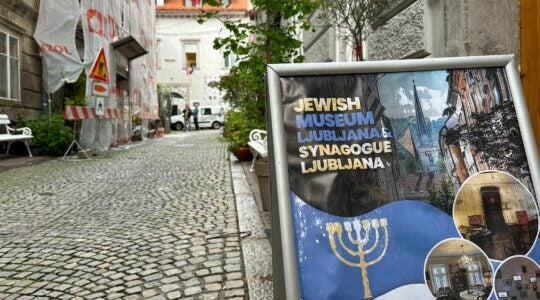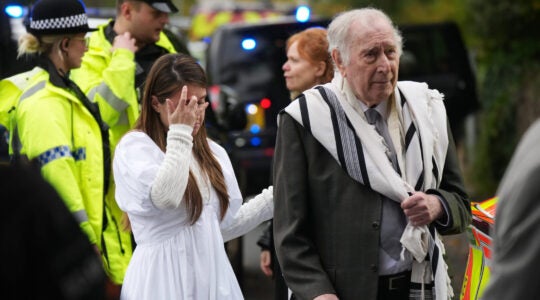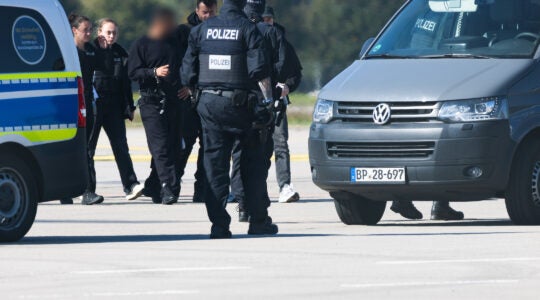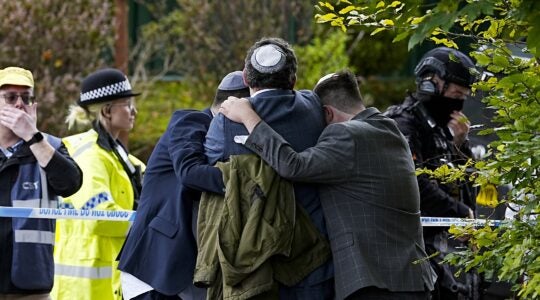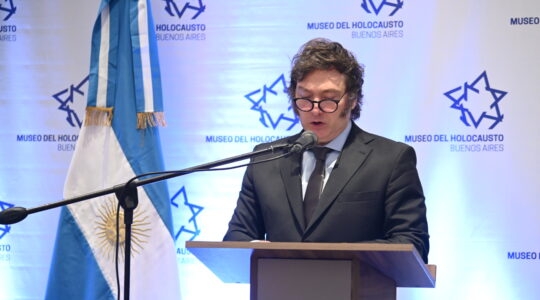
A previously unknown document obtained by JTA shows that concern in 2001 about fraud at the Claims Conference reached the highest levels of the organization.
NEW YORK (JTA) — A document obtained by JTA shows that top officials of the Claims Conference were sufficiently concerned by allegations of fraudulent restitution claims that they launched their own probe in 2001, nearly eight years before the $57 million scheme was finally detected.
The Claims Conference has said in recent days that failure to heed early warnings of the fraud lies with a now-dead regional director. But the new document shows that two senior officials — the organization’s chief professional at the time, Gideon Taylor, and its counsel, Julius Berman — conducted their own investigation, which failed to uncover the extent of the scheme.
The probe resulted in an eight-page report that raised questions about the handling of several fraudulent cases by Semen Domnitser, a Claims Conference employee who was found guilty on May 8 of orchestrating the $57 million scheme.
The revelation of the report leaves unanswered the question of whether Claims Conference leaders showed gross negligence in failing to detect that Domnitser was orchestrating a widespread fraud, as some critics contend, or whether Domnitser, who was questioned in the two 2001 probes, was such a shrewd operator that Claims Conference officials couldn’t help but be fooled.
[UPDATE: Jewish Agency chairman Natan Sharansky adds voice to calls for an independent investigation of the Claims Conference.]
The first probe was sparked by an anonymous letter in June 2001 alleging that five fraudulent claims had been approved for restitution payments. The letter reached the director of the Claims Conference office in Germany, Karl Brozik, who conducted an assessment that included questioning Domnitser about his handling of the claims.
Domnitser responded to Brozik by fax, acknowledging some inadvertent errors but lying about other facts to cover up his criminality. Brozik shared Domnitser’s responses with the staffer he had assigned to look into the matter, who marked them up with many question marks. But there is no evidence in the public record indicating that the inquiry was taken further, and last week Claims Conference spokeswoman Hillary Kessler-Godin blamed Brozik, who died in 2004, for failing to pursue the matter.
However, it turns out that the Claims Conference’s top leaders launched a second probe of their own.
The investigation was assigned to a paralegal at Berman’s law office, Kaye Scholer LLP, who went to the Claims Conference office in New York on Aug. 27, 2001 to review the five fraudulent claims and question Domnitser.
The paralegal, Ryan Tan, produced a report that Berman sent to Taylor on Sept. 5, 2001. The report, a copy of which was obtained by JTA, raised questions about Domnitser’s handling of the fraudulent cases but did not suggest Domnitser was a party to fraud.
“A majority of the claims made by the person who wrote the anonymous letter were refuted by Mr. Domnitser,” the report said. “However, the accusations did raise further questions about the way the cases were handled by the Conference.”
In reference to one case, Tan wrote, “Mr. Domnitser has indicated that a caseworker named Voskreskney also handled the case, but no signature or stamp bearing that person’s name appear on the file. Further inquiry is needed in this case. An interview with [Claims Conference caseworker] Krylyak may clarify some of the discrepancies in this matter.”
Another case involved Mariya Fortel, the sister of Polina Berenson, a Claims Conference employee who pleaded guilty in March to participating in the fraud. After noting that Fortel received payment from two separate restitution funds in violation of the rules, Tan wrote, “Because the Conference does not allow the applicants to receive both funds, Mr. Domnitser explained during the interview that Fortel had to forfeit the DM 5,000 that she obtained from the Hardship Fund. Unfortunately, the file does not contain a record that this money was ever given back or deducted.”
The report contains no smoking gun fingering Domnitser as perpetrating the fraud, and it’s not clear how common allegations of fraud were at the Claims Conference. However, the report demonstrates that the organization’s top leaders considered the matter sufficiently alarming that they had someone outside the organization conduct a separate probe even after an internal inquiry had been conducted two months earlier.
After Berman and Taylor received the Kaye Scholer report, Domnitser and his cronies managed to fleece the Claims Conference of millions more for another eight years.
In an email to JTA, Taylor blamed Brozik for dropping the ball, saying Brozik oversaw the review of the allegations in the 2001 letter and was sent the Kaye Scholer report.
“The report indicated that there should be specific follow up on allegations about the improper processing of five cases involving Claims Conference staff members,” Taylor wrote. “Karl Brozik subsequently indicated to me that no further action regarding the New York staff was required concerning the issues in the report.”
In all, at least six senior Claims Conference figures were made aware in 2001 of the allegations involving fraud, though some were not privy to all the details: Domnitser, who perpetrated the fraud; Brozik, who is dead; Taylor, who left the conference in mid-2009 and now works in real estate; former Claims Conference chief Saul Kagan, who is in his 90s and retired; Berman; and Greg Schneider, then assistant executive vice president and director of allocations and now the Claims Conference’s chief executive.
Of the six, only Berman and Schneider still play prominent roles at the organization.
Berman, who is also a member of JTA’s board, was traveling as of press time and could not be reached for comment. But the Claims Conference released a statement to JTA attributed to Berman in which he cites recent error-laden news reports about the 2001 episode and notes that he has appointed a committee to “review all of the materials and recommend a course of action.”
“In deference to the work of that committee,” Berman said, “the Claims Conference will not publicly comment on any aspect of events that fall within the purview of the Committee until after the committee has concluded its work.”
In an interview with JTA in late 2011, Berman, who had been chairman of the Claims Conference for about 10 years, rejected the notion that he bore any responsibility for failing to detect the fraud over the years.
“I feel no fault at all,” Berman said in the interview, excerpts of which were published in a 2012 JTA profile of Schneider. “No one has ever suggested that I should resign.”
Calling the controls in place at the Claims Conference to prevent fraud “reasonably adequate,” Berman said the deception was as impossible to anticipate as the attacks of 9/11.
“Until it happens once,” he added. “Then you’re on notice that something you never foresaw can happen.”
Schneider declined to comment to JTA, but last week Kessler-Godin told JTA that Schneider is not to blame because he never saw the original anonymous letter and the others CC’d on the correspondence were senior to him. Therefore, Kessler-Godin said, Schneider reasonably assumed they were handling the matter.
Ultimately, it was Schneider who finally halted the massive fraud scheme when he and a colleague, Karen Heilig, came across a pair of suspicious claims approvals in November 2009 and began to investigate further. They quickly found hundreds more suspicious cases — what turned out to be the tip of the iceberg in a fraud scheme involving nearly 5,000 falsified claims.
Within hours, Schneider alerted Berman. They had the law firm of Proskauer Rose LLP do an initial investigation, and a few weeks later the conference alerted the FBI. Eventually, a total of 31 people were arrested in connection with the scheme. Twenty-eight pleaded guilty; the three who did not, including Domnitser, were found guilty at trial on May 8.
In all, there were at least 3,839 falsified applications to the Hardship Fund, an account established by the German government to provide one-time payments of approximately $3,360 to those who fled the Nazis as they moved east through Germany, and 1,112 false claims to the Article 2 Fund, through which the German government gives pension payments of approximately $411 per month to needy Nazi victims who spent significant time in a concentration camp, in a Jewish ghetto in hiding or living under a false identity to avoid the Nazis.
Domnitser oversaw the two funds.
The September 2001 Kaye Scholer report was unearthed at the Claims Conference’s Germany office in 2010 by those working on rooting out the fraud, Kessler-Godin told JTA, and the report subsequently was passed along to the FBI. The prosecution did not use the material during the fraud trial and thus it did not appear in the trial’s public record.
However, the original 2001 anonymous letter did, and the prosecution cited it as evidence of Domnitser’s shrewdness at misleading his superiors. The Forward was the first news outlet to report the letter’s existence.
JTA has documented Jewish history in real-time for over a century. Keep our journalism strong by joining us in supporting independent, award-winning reporting.



